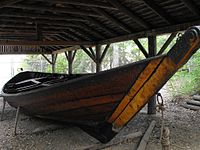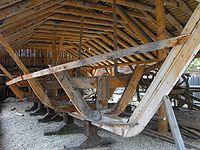- York Factory Express
-
The York Factory Express, usually called "the Express" and also called the Columbia Express and the Communication, was a brigade operated by Hudson's Bay Company in the early 19th century connecting York Factory and Fort Vancouver. It was named "express" because it was not used only to transport furs and supplies but also to quickly move departmental reports and letters. It was the main overland connection between the Columbia Department and the Hudson's Bay Company's headquarters at York Factory. Bulk cargo to and from the Columbia Department was shipped by sea. The express brigade was known as the York Factory Express on its eastbound journey in the spring, and as the Columbia Express or Autumn Express on its westbound journey in the fall. The same route was used in both cases. Its length was about 4,200 kilometres (2,600 mi). To expedite messages the express messengers would often speed ahead of the main bodies carrying supplies and furs.
Contents
History
The York Factory Express evolved from an earlier express brigade used by the North West Company between Fort George (originally Fort Astoria founded in 1811 by John Jacob Astor's American Fur Company), at the mouth of the Columbia River, to Fort William on Lake Superior.[1]
In 1821 the North West Company was forcibly merged (at the behest of the British government) into the Hudson's Bay Company after armed conflict in the Red River Settlement between the two companies.[2] George Simpson, director of Hudson's Bay Company, visited the Columbia District in 1824-25, journeying from York Factory. He investigated a quicker route than previously used, following the Saskatchewan River and crossing the mountains at Athabasca Pass. This route was thereafter followed by the York Factory Express brigades.[3]
By 1825 there were usually two brigades, each setting out from opposite ends of the route, Fort Vancouver in the Columbia District on the lower Columbia River and the other from York Factory on Hudson Bay, in spring and passing each other in the middle of the continent. Each brigade consisted of about forty to seventy five men and two to five specially made boats and travelled at breakneck speed (for the time). Indians along the way were often paid in trade goods to help them portage around falls and unnavigable rapids. An 1839 report cites the travel time as three months and ten days—almost 26 miles (40 km) per day on average.[1] These men carried supplies in and furs out by boat, horseback and as back packs for the forts and trading posts along the route. They also carried status reports for supplies needed, furs traded etc. from Dr. John McLoughlin head of the Oregon Country HBC operations, and the other fort managers along the route. This continued until 1846, when the lower Columbia district was ceded to the United States by the Oregon Treaty.
The supplies were brought into Fort Vancouver and York Factory by ship every year (they tried to maintain one year's extra supplies to avoid disastrous ship wrecks etc.). The furs they had traded were shipped back on the supply ships with the furs from Fort Vancouver often being shipped to China where they were traded for Chinese goods before returning to England. The furs from York Factory being sold in London in an annual fur sale.
James Sinclair followed the southern portion of the route in 1841, when he brought nearly 200 HBC settlers from the Red River Settlement (located near the junction of the Assiniboine River and Red River near present Winnipeg, Canada) into the Columbia District. This attempt at British settlement failed because Fort Vancouver's Chief Factor McLoughlin was slow to settle them; so most of the families eventually joined the American Oregon settlers for the promise of free land in the Willamette Valley south of the Columbia River.
Transport
 York boat replica at Fort Edmonton Park, Edmonton, Alberta
York boat replica at Fort Edmonton Park, Edmonton, Alberta
An inland boat, the York boat, was used to carry furs, trade goods along inland waterways in Rupert's Land and the Columbia District. The express brigades also used these boats, although they did not carry bulk cargo. The boats were named after their destination: York Factory headquarters of the HBC, and were modeled after Orkney Islands fishing boats (themselves a descendant of the Viking long boat). York Boats were preferable to the canoes, used by North West Company Voyageurs as a cargo carriers, because of its larger size, greater capacity, and improved stability in rough water. The boat's heavy wood construction also gave it an advantage in travelling through rocks or ice; it was much more immune to tears and punctures. That advantage became a disadvantage, though, when portaging was necessary. The boat was far too heavy to carry, and it was necessary instead to cut a path through the brush, lay poplar rollers, and laboriously drag the boat overland. The mountainous terrain of the Pacific Northwest necessitated the regular use of pack horses over significant portions of the fur brigade routes.
A style of boat slightly different from the York boat was made specifically for use in the Columbia District and constructed on the Columbia River. In 1811 the American Pacific Fur Company introduced the use of bateaux on the Columbia River, heavy boats made of split or sawn cedar. After the NWC took over the PFC the practice of using bateaux was quickly adopted, birch bark canoes having proved too dangerous on the rivers of the Pacific Northwest. In the 1820 Joe McKay of the HBC described the Columbia District bateaux as "made from quarter-inch pine board, and are thirty-two feet long, and six and a half feet wide in midships, with both ends sharp, and without a keel—worked, according to the circumstances of the navigation, with paddles, or with oars."[1]
Route
From west to east, Fort Vancouver to York Factory, the express route ran as follows. Up the Columbia River past the posts of Fort Nez Perces, Fort Okanogan, and Fort Colvile to Boat Encampment (today under Kinbasket Lake), then over Athabasca Pass to Jasper House, down the Athabasca River to Fort Assiniboine, then overland to Fort Edmonton. Thence down the North Saskatchewan River and Saskatchewan River to Lake Winnipeg and via Norway House on the Nelson River. Finally the brigade would travel down the Hayes River to York Factory on Hudson Bay.[4][5]
References
- ^ a b c Mackie, Richard Somerset (1997). Trading Beyond the Mountains: The British Fur Trade on the Pacific 1793-1843. Vancouver: University of British Columbia Press. pp. 16–17, 61. ISBN 0774806133. OCLC 82135549. http://books.google.com/books?id=VKXgJw6K088C.
- ^ Lass, William E. (1980). Minnesota's boundary with Canada: its evolution since 1783. Minnesota Historical Society. p. 72. ISBN 9780873511537. http://books.google.com/books?id=wXAu-xA3y3gC&source=gbs_navlinks_s.
- ^ Mackie, Richard Somerset (1997). Trading Beyond the Mountains: The British Fur Trade on the Pacific 1793-1843. Vancouver: University of British Columbia Press. p. 46. ISBN 0774806133. OCLC 82135549. http://books.google.com/books?id=VKXgJw6K088C.
- ^ Mackie, Richard Somerset (1997). Trading Beyond the Mountains: The British Fur Trade on the Pacific 1793-1843. Vancouver: University of British Columbia Press. pp. 97. ISBN 0774806133. OCLC 82135549. http://books.google.com/books?id=VKXgJw6K088C.
- ^ Meinig, D.W. (1995) [1968]. The Great Columbia Plain: a historical geography, 1805-1910 (Weyerhaeuser Environmental Classic edition ed.). Seattle: University of Washington Press. p. 69. ISBN 9780295974859. OCLC 32968510.
Categories:- Hudson's Bay Company
- Historic trails and roads in Canada
- Historic trails and roads in Washington (state)
- Historic trails and roads in Oregon
- Shipping routes
Wikimedia Foundation. 2010.


